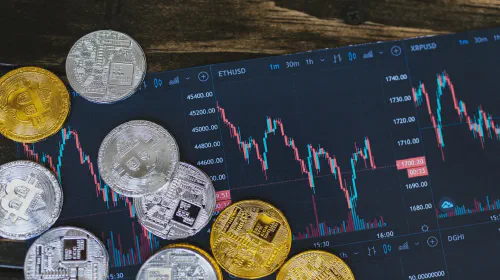What Are Commodity-Backed Stablecoins?
Salomon Kisters
Aug 30, 2022This post may contain affiliate links. If you use these links to buy something we may earn a commission. Thanks!
Stablecoins were invented to introduce stability to the cryptocurrency market. However, like everything else in the crypto world, they are constantly undergoing innovation to ensure that they keep getting improved and more stable. There are a couple of different types of stablecoins, each with its own benefits and drawbacks. Commodity-backed stablecoins are one of the most prominent types of stablecoins found in the market today.
Commodity-backed stablecoins achieve the promise of stability by tying themselves to real-world assets like gold, silver, and platinum. But how exactly does this work? To understand the significance of commodity-backed stablecoins, we first need to take a look at how stablecoins work in the cryptocurrency market.
The Usability of Stablecoins
A stablecoin’s value depends on the trust of the holder in the collateralized reserve asset. The platform is required to declare its solvency to maintain the value of the cryptocurrency. Investors in stablecoins can use them to buy groceries, pay fares, and settle bills with them. A stablecoin can be a good choice for passive income if you are looking for a means to invest.
In addition to their monetary value, stablecoins are also good for lending crypto across platforms. In the case of fiat-backed stablecoins, the issuer must hold an equivalent reserve amount of gold to back the digital currency. This is true for both commodity-backed and fiat-backed stablecoins. As long as you hold your stablecoins for a long time, they’ll maintain their value and can be redeemed.
What are Different Types of Stablecoins?
There are several types of stablecoins, but the three main types are fiat-backed, crypto-backed, and commodity-backed stablecoins. Fiat-backed stablecoins are generally easier to use and are traded on exchanges.
A cryptocurrency-backed stablecoin has a reserve of another cryptocurrency. Most stablecoins use Bitcoin or Ethereum as collateral, but they are always overcollateralized to account for fluctuations in the market. If you’re unsure whether the cryptocurrency you’re investing in is stable enough, make sure the reserve amount is higher than the circulating supply.
Fiat-backed stablecoins are backed with fiat currency, and their value is tied to the value of that asset. Reserves are held by a third-party financial entity and must match the total number of stablecoins in circulation. Fiat-backed stablecoins are a trusted way to invest in crypto. Because they are backed by trust, they have more value than a fiat currency.
A commodity-backed stablecoin, on the other hand, is backed by a physical asset that you can redeem in case of a price drop. The most common type is gold, but other types include precious metals, like silver or copper.
Commodity-backed Stablecoins
Commodity-backed stablecoins are digital currencies backed by real assets such as gold, oil, or other commodities. They are designed to offer greater access to investors who want to invest in cryptocurrency but want something more reliable. Thus, they might invest in commodity-backed stablecoins, which are tied to the value of the underlying asset.
A commodity-backed stablecoin is a cryptocurrency whose value is backed by some tangible asset, such as gold. For example, Paxos Gold (PAXG) is pegged to the price of one fine troy ounce of gold in the London Good Delivery market, which is currently $1,800. Tether Gold (XAUt) is another gold-backed stablecoin.
What Makes Commodity-backed Stablecoins Special?
Commodity-backed stablecoins are less susceptible to inflation than fiat currencies. In addition to holding the same value as the collateral, these currencies can be liquidated when needed. And because they are less volatile than fiat money, they’re a great choice for investors who cannot access precious materials. The only drawbacks of commodity-backed stablecoins are that they’re less liquid than other cryptocurrencies and fiat.
Even though they are difficult to liquidate, commodity-backed stablecoins are still a lot safer than other forms of stablecoins, especially algorithmic stablecoins. The most notable example of how risky algorithmic stablecoins can be is the TerraUSD, which lost its peg in May 2022. Its value has dropped next to nothing, along with the value of its native currency, LUNA.
In addition to being less volatile, commodity-backed stablecoins are often used as payment methods. Because they are backed by tangible assets, such as gold, they are less volatile than traditional cryptocurrencies.
In addition, these assets tend to hold their value better during times of economic inflation. These coins also allow investors to purchase hard-to-source assets. Physical gold, for example, is expensive and difficult to access in many places. However, a commodity-backed stablecoin allows investors to access the benefits of physical gold without the costs and difficulties associated with physical gold.
Let’s take a look at a few types of commodity-backed stablecoins.
Pax Gold – PAXG
Each token of PAXG is backed by one fine troy ounce of a 400-ounce London Good Delivery gold bar, stored in the vaults of Brink. It is built as an ERC-20 token on the Ethereum blockchain. The parent company, Paxos, is regulated by the New York State Department of Financial Services. It is also regulated and approved by DFS, and the physical gold reserves are tested by an auditor every month.
PAXG prides itself on being the only token that you can redeem for LMBA-accredited Good Delivery gold bullion bars. Long-time customers can also redeem their PAXG for unallocated Loco London Gold. The fee for the creation of a PAXG token ranges from 0.03% to 1%, depending on the volume that you’re minting.
As of August 12, 2022, PAXG is trading at $1783, the circulating supply is 339,687 PAXG, and the market cap is at $605,816,457.
SilverTokens – SLVT
Just like PAXG, SLVT is an ERC-20 token on the Ethereum blockchain. As is apparent by its name, SLVT allows you to own silver – digitally. Each token represents 1.035732 ounces of investment-grade silver. The value of each Silver Token increased by a whopping 60% in 2020 alone.
SilverTokens puts half of every transaction fee towards adding more silver to its vaults, increasing the amount of silver the owners of SLVT tokens carry over time. The physical silver is stored in 12 private vaults in politically neutral countries. The silver is also ensured by Llyod’s of London.
The vision of the founder, Richard Malik, is to make sure “everyone can own privately vaulted silver and use that silver as money.” As of August 12, 2022, SLVT is trading at $23.37.
PlatinumCoin
Platinum Coin is also an ERC-20 token based on the Ethereum blockchain. One Platinum Coin represents 1/1000th of an oz. of 99.9% pure platinum. The physical vaults holding the platinum are regularly audited, and the results are visible online for complete transparency.
Using Platinum Coin is affordable, and it’s quite economical to own platinum as an asset. It is a private asset. Thus, you require no personal information to buy/sell it.
Palladium - Nornickel
The digitization of all forms of assets is allowing many countries to go around trade embargos and international regulations to sell their assets. A prime example would be the company Nornickel, owned by the Russian oligarch Vladimir Potanin. The Russian mining company announced in 2019 its intention to digitalize its commodities.
Nornickle tokenized palladium with Atomyze, a tokenization platform owned by Nornickle itself. It is based on the Hyperledger Fabric, a blockchain designed by IBM. Since Hyperledger Fabric is an open-source project, it has received contributions from some of the best minds around the world and is one of the most advanced blockchain technologies out there.
The Future of Commodity-Backed Stablecoins
The development of stablecoin is an important step toward the broader adoption of cryptocurrencies. They make it easier to invest in out-of-reach assets, such as gold bars and real estate. Purchasing gold/silver/platinum and other precious metals is expensive and difficult, so owning tangible assets is not practical for most people in many parts of the world. Commodity-backed stablecoins make it easier to get physical ownership of the tokenized assets while maintaining a certain level of price stability.
While we have mentioned some top projects in the world of commodity-backed stablecoins, the industry is by no means limited by them. With improving blockchain technology and increased acceptance of cryptocurrency around the world, it is evident that you will eventually be able to buy real estate, vintage cars, ships, and any other asset that you can think of in the form of a token on the blockchain.
It would break all the international barriers there are in the way of efficient trade and asset ownership. A man sitting in China could own a basketball court in Brooklyn, and a man sitting in New Jersey could be the proud owner of a comic book shop in Japan. The possibilities are endless!
Stay informed with the latest insights in Crypto, Blockchain, and Cyber-Security! Subscribe to our newsletter now to receive exclusive updates, expert analyses, and current developments directly to your inbox. Don't miss the opportunity to expand your knowledge and stay up-to-date.
Love what you're reading? Subscribe for top stories in Crypto, Blockchain, and Cyber-Security. Stay informed with exclusive updates.
Please note that the Content may have been generated with the Help of AI. The editorial content of OriginStamp AG does not constitute a recommendation for investment or purchase advice. In principle, an investment can also lead to a total loss. Therefore, please seek advice before making an investment decision.

How Many Binance Coins Are There and How Many Are Left?
BNB has managed to become the third-most-popular crypto token in the world. But how many Binance coins are there, and how many are left?

Cardano Tokens: Total Issued and Circulating vs. Bitcoin's Limited Supply
Learn about the total number of Cardano tokens, with 45 billion issued and 11.1 billion still in circulation. Compare this to Bitcoin's limited supply of 21 million tokens.
Protect your documents
Your gateway to unforgeable data. Imprint the authenticity of your information with our blockchain timestamp